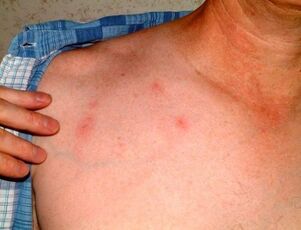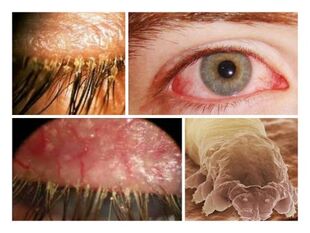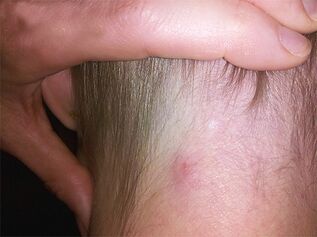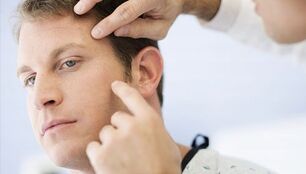
Pictures and videos of subcutaneous parasite symptoms in humans are not a pleasant sight. Unlike intestinal worms, the existence of which a person may not even know, epithelial infections are easy to see. In this case, a person feels constant discomfort due to the symptoms that accompany the lesion. This helps to start diagnosing the disease as soon as possible and start treatment. A picture of subcutaneous parasites in humans causes emotions close to disgust, but the symptoms of the infection are much more unpleasant. The picture does not convey a person’s feelings from the sense that someone is crawling along his body. But epithelial infections are not only a concern, but also a significant risk to the health of the whole organism. Toxins secreted by the parasite body can affect all organ systems, and the helminths themselves want to spread throughout the human body. So the manifestation of dermatological problems can be a sign of danger to the patient's life due to the presence of helminths in the brain, visual organs or heart.
Which parasites live on the skin?
Dermatological problems can cause a wide variety of infections. If, during intestinal infection, the presence of worms is most often diagnosed, then insects and protozoa can also be found under the skin. Mosquitoes, ticks and other blood-sucking parasites usually feed and detach from humans unnoticed, but there are those that continue to live and multiply in the body.
Each of these types of infections has its own ways of entering the human body. The symptoms and effects of the infection also vary greatly. Therefore, the treatment of the disease will take place in different ways. But to distinguish one parasitic infection from another and to determine who lives in the body, it is necessary to undergo a lengthy diagnosis. The doctor, knowing the characteristics and habitats of the various parasites, will show you the most likely option even before the tests begin, focusing only on the symptoms and the patient's travel map around the world.
Parasitic microorganisms
The most common disease of this type is leishmaniasis. It is caused by the simplest parasites, which gave the name to the pathology. 9 out of 10 infections occur in only a few places:

- Syria;
- Irani;
- Saudi Arabia;
- Afghanistan;
- Peru;
- Brazil.
The disease is transmitted by mosquitoes and some species of flies. Pathogenic microorganisms do not survive in mild climates, so you can only become infected with leishmaniasis after resting in hot places with a tropical climate.
When infected, the infection forms ulcers at the site of the insect bite. Over time, it heals and leaves a messy scar. With multiple foci, leishmaniasis can look like leprosy. The risk of this disease is that it passes from the skin to the lymphatic system and can affect the internal organs, gradually destroying them. In this case, the parasites live inside the cells, so the immune bodies are very little useful in fighting the protozoa. But after a single experience of fighting leishmaniasis, immunity is formed.
Insects among subcutaneous parasites
Diseases caused by such an invasion are called entomoses. There are several types of these subcutaneous parasites in humans:
Sarzopsiloza (tungioza).Called by tropical sand fleas. It is enough to walk barefoot on the beach or lie down sitting in the sun for the insect to crawl on the body. It is invisibly hidden under the outer layer of the epithelium until the blood is absorbed. The flea then "gets fat" and begins to press on the surrounding tissue, causing discomfort. When it dies, it is excreted from the body with dead skin being stripped. If this does not happen, the tissues can become infected and abscessed.
Most often, insects that settle in the human body live in southern countries, because their development requires a stable hot climate. But in some cases, it is enough to visit the sea in summer in order to then fight subcutaneous parasites for several months.
Parasitic worms and more
Subcutaneous worms in humans are not difficult to detect. They usually give their location in the same way as other infections - through redness, itching and burning. But in some cases, the epithelium is only an intermediate stop and the main development of the pathology continues in the internal organs:
- Dirofilariaza.There are several species of these helminths. Some prefer to be placed on the internal organs, but there are those that affect the skin and eyes. The parasite larvae are carried by mosquitoes and are found in warm regions. A painful, soft, mobile lump swells at the site of the lesion. It is not dangerous if the infection does not affect the visual organs. But requires surgery for treatment.
- Drakunculiaza. The new worm enters the body with water containing small crustaceans that store larvae in their stomach. Through the intestines, helminths penetrate the abdominal cavity, where they mate and lay eggs in the muscle tissue in the area of the joints and bones of the leg. When the young worm matures, the larva pierces the skin and emerges. The only way to relieve the burning sensation and pain is to place the limb in water. Other methods to get rid of the parasite that has settled in the body have not yet been invented.
- Schistosomiaza.Not all worms under human skin get there with food. To get infected with schistosomes, it is enough to swim in the fresh waters of the tropical countries of South America, the Caribbean, Africa or Southeast Asia. The skin lesion resembles scabies and is accompanied by a tingling sensation. But after a while, the larvae make their way deep into the body, after which the epithelial symptoms disappear and the next stage of the disease develops.
- Gnathostomoza. Humans are not natural hosts for this parasite. Therefore, worms cannot reproduce in the body. Therefore, the Asian parasite, entering the body with insufficiently thermally processed fish, frogs or birds. The larvae begin to migrate after a month. Moving under the skin, they cause itching, redness and pain. Appearance in the abdomen is accompanied by edema.

Once the first signs of helminth life appear under the skin, the patient should be examined and treatment initiated. Many parasites can significantly worsen their health condition, including disability, if not removed in time.
Diagnostic procedures
Given the variety of parasites that live under a person's skin, there is no universal method that would help determine the cause of the disease. Also, we must not forget that insects and worms are not the only possible sources of dermatological problems. Allergic reactions, fungal growths and bacterial infections are much more likely to cause urticaria and dermatitis.
The first phase of searching for parasites on human skin begins with an examination. The doctor conducts a study, examines the affected areas and looks for other symptoms. So he will be able to narrow the search area and in some cases, for example, with dracunculosis and dirofilariasis, immediately prescribe treatment.
If the physical examination did not help to fully clarify the appearance, laboratory and hardware diagnostic methods are prescribed:
- Blood test.General analysis reveals the appearance of the body's reactions to the infection. So a specialist can determine the nature of the disease. When performing biochemistry, it is worth paying attention to indicators of erythrocyte sedimentation rate and eosinophil content. If they are elevated, it means that helminthiasis is quite possible. The ELISA analysis is more accurate. This will help to determine from the presence of antibodies also the exact type of parasite, if any is present in the body.
- Stool analysis.Many subcutaneous worms are initially based inside the intestines. By examining the feces, you can find the helminth eggs and start treatment.
- Biopsy.Analysis of affected tissues, purulent abscess contents and blisters, swollen lymph nodes may also reveal a picture of the disease.
- Ultrasound, X-ray, CT and MRI.Various hardware methods of "scanning" the body will help locate the source of infection under the skin and in the internal organs. In some cases, this is the only effective diagnostic method.

Some infections can only be diagnosed after treatment, when the parasite is removed from under the skin.
Treatment of parasitic diseases
Depending on the type of parasite, doctors should use different methods to get rid of the infection:
- The simplest microorganisms are destroyed with a course of antibiotics. It is necessarily accompanied by symptomatic treatment.
- You can get rid of ticks using specialized oils and tablets. At the same time, dermatobiasis can only be cured by surgery, removing the larvae under the skin.
- The method of treatment for helminthiasis depends directly on the type of parasite. So dirofilariasis is only treated surgically. Anthelmintics will help remove schistosomes and intestinal parasites. And treatment of dracunculosis is not provided at all. A person has to wait for the worm to leave the body on its own and fight the symptoms: pain and inflammation.
In any case, it is necessary to undergo a thorough examination by a doctor and start treatment under his guidance to ensure complete elimination of parasites.






































